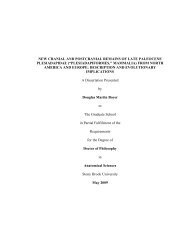Changes in nearest-neighbor associations in a captive group of ...
Changes in nearest-neighbor associations in a captive group of ...
Changes in nearest-neighbor associations in a captive group of ...
Create successful ePaper yourself
Turn your PDF publications into a flip-book with our unique Google optimized e-Paper software.
274 McCann and Rothman<br />
cepted their close proximity, although this was not systematically determ<strong>in</strong>ed. These<br />
f<strong>in</strong>d<strong>in</strong>gs are similar to those reported by Kirkevold and Lockard [1992] that show<br />
silverback males rarely <strong>in</strong>itiate contact with <strong>in</strong>fants. Despite his lack <strong>of</strong> <strong>in</strong>itiat<strong>in</strong>g<br />
close proximity to the <strong>in</strong>fants, M1 spent the most time (67.8%) near the <strong>in</strong>fants compared<br />
to any other female (19.2–37.8%), and the cluster most <strong>of</strong>ten <strong>in</strong>cluded him<br />
than any <strong>of</strong> the females. For the <strong>in</strong>fants, it appeared that M1 provided protection and<br />
a sense <strong>of</strong> security for them. Their closeness to him allowed them protection from<br />
other <strong>group</strong> members’ more aggressive approaches. For example, whenever any <strong>of</strong><br />
the <strong>in</strong>fants were distressed, usually due to the persistent approaches <strong>of</strong> the sub-adult<br />
females, M1 would come to their aid and <strong>in</strong>tervene <strong>in</strong> the encounter. This is <strong>in</strong> accordance<br />
with data reported from wild populations <strong>of</strong> gorillas that showed that <strong>in</strong>fants<br />
are <strong>of</strong>ten attracted to the silverback because <strong>of</strong> his role as protector [Schaller, 1963;<br />
Stewart and Harcourt, 1987]. As a result, the silverback can play a pivotal role <strong>in</strong> the<br />
assimilation <strong>of</strong> <strong>in</strong>fants <strong>in</strong>to established <strong>group</strong>s [Fossey 1976, 1979; Van Elsackler et<br />
al., 1990).<br />
Infant Nearest-Neighbor Associations<br />
The most significant result regard<strong>in</strong>g the <strong>in</strong>fants’ <strong>in</strong>troduction <strong>in</strong>to the <strong>group</strong><br />
was their strong dependence on each other for support and reassurance. For an overwhelm<strong>in</strong>g<br />
amount <strong>of</strong> the time observed, another <strong>in</strong>fant was the <strong>nearest</strong> <strong>neighbor</strong> <strong>of</strong><br />
each <strong>of</strong> the <strong>in</strong>fants (Fig. 3), and when an <strong>in</strong>fant was the <strong>nearest</strong> <strong>neighbor</strong> to another<br />
<strong>in</strong>fant, the distance was smaller compared to when that <strong>in</strong>fant was <strong>nearest</strong> <strong>neighbor</strong><br />
to an adult. M1’s <strong>of</strong>fspr<strong>in</strong>g (I1, I4, and I5) spent so little time with other adults<br />
(






